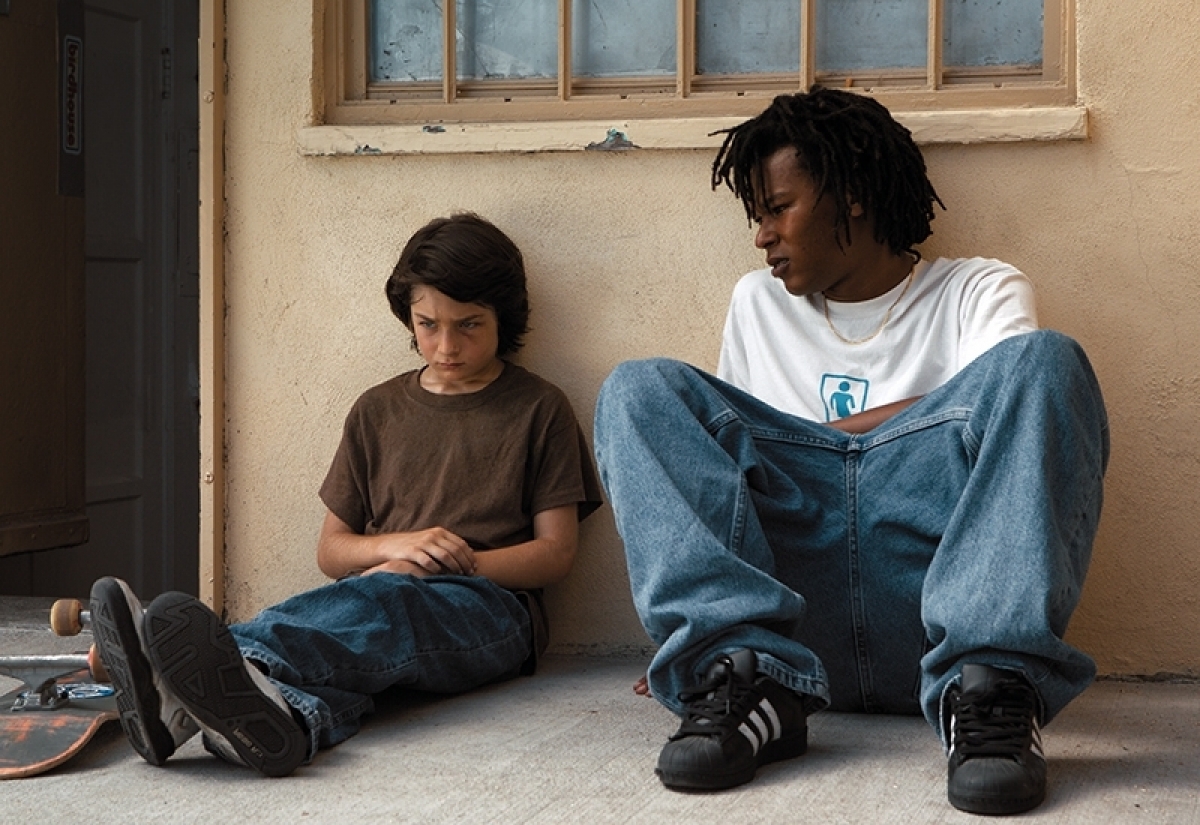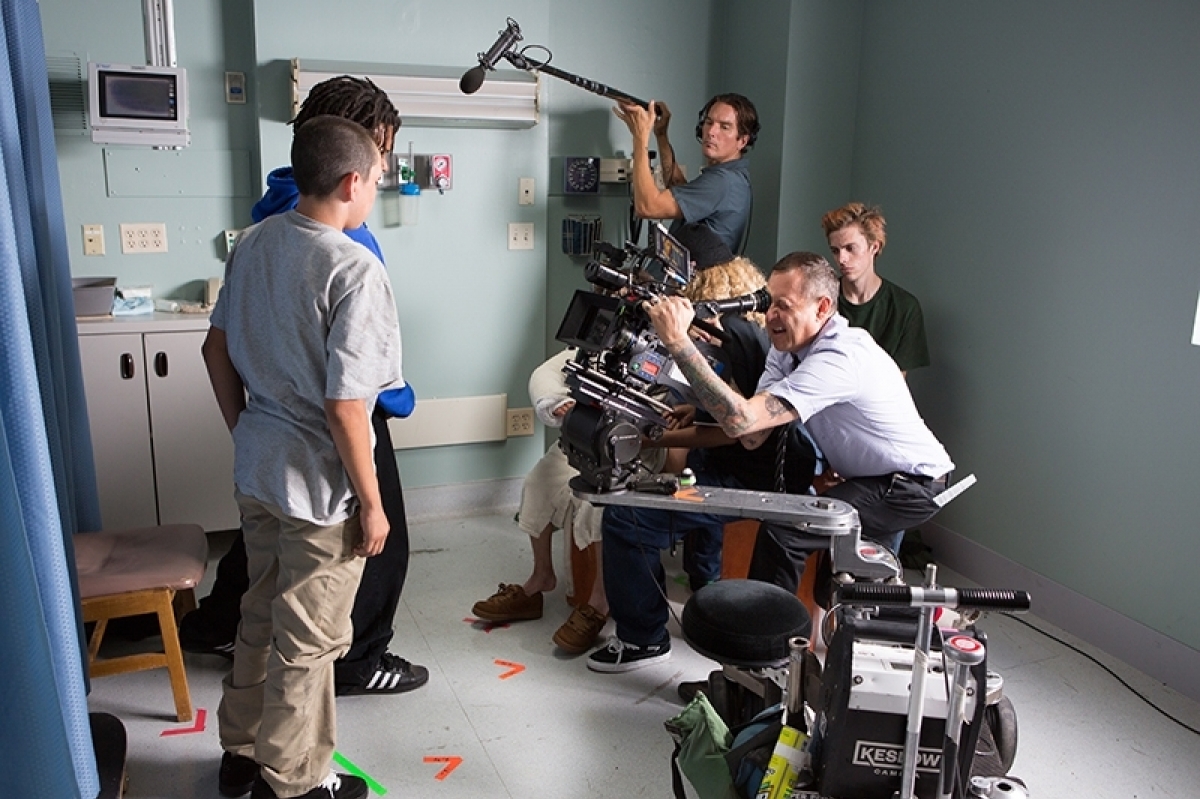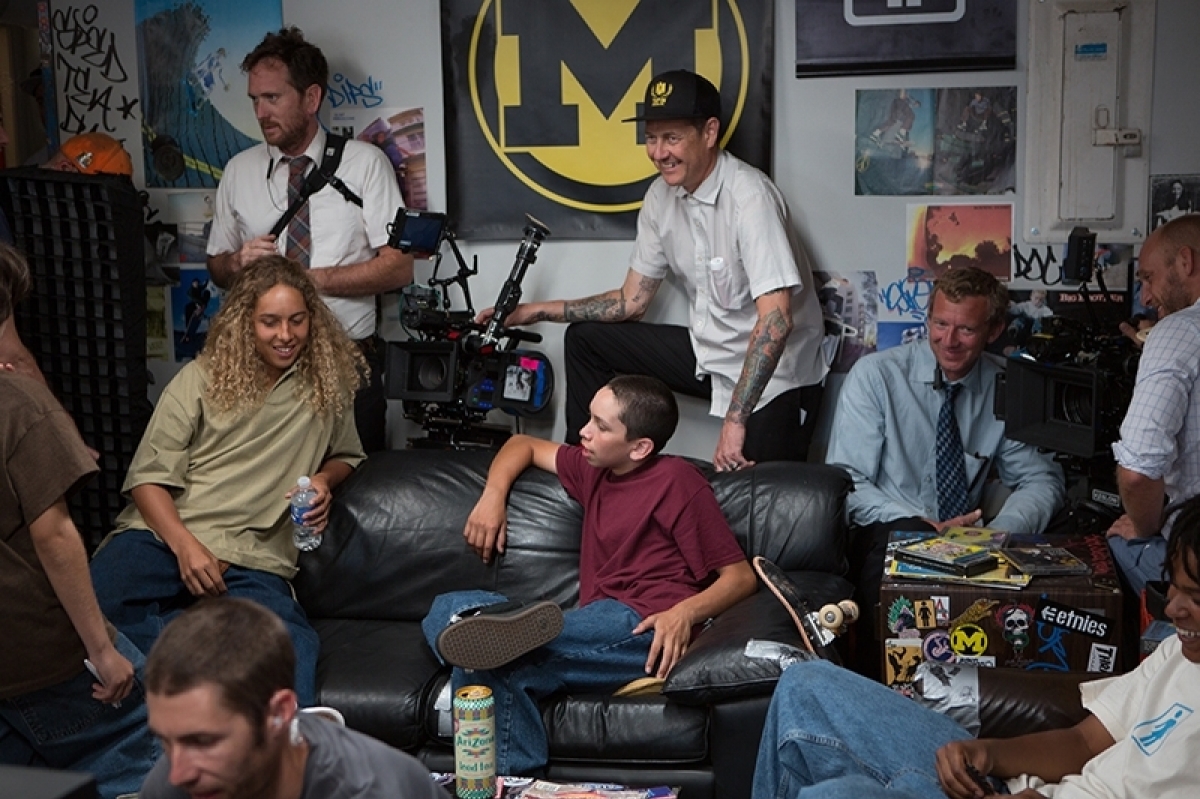Kodak Super 16mm brings heart and soul to Jonah Hill’s coming-of-age picture 'Mid90s'

Olan Prenatt and Ryder McLaughlin in Mid90s. Photo by Tobin Yelland. (c) 2018 A24.
Created on Kodak Super 16mm, the acclaimed feature Mid90s follows Stevie, a thirteen-year-old boy in 1990s Los Angeles, who spends the summer navigating between his troubled home life and a group of new friends he meets at a skate shop on Motor Avenue in Culver City.
The $5M, A24/Waypoint Productions’ movie, produced by Eli Bush and Scott Rudin, marks the directorial feature debut of Jonah Hill, known for his Oscar-nominated acting performances in Bennett Miller’s Moneyball (2011) and Martin Scorsese’s TheWolf of Wall Street (2014). Shot by cinematographer Christopher Blauvelt, Mid90s received widespread critical acclaim on the festival circuit worldwide, along with a best feature nomination at the 2019 Berlin Film Festival.

Behind the scenes shot of cinematographer Christopher Blauvelt at work during production on Mid90s. Photo by Tobin Yelland. (c) 2018 A24.
“This was a passion project for Jonah, based around his own personal experiences of growing up in L.A. – full of heart, with both funny and pitch-dark moments by turn,” says Blauvelt, himself a winner of 2014 Sundance Film Festival Cinematography Award for his Super 16mm work on Jeff Preiss’s Low Down. Blauvelt’ other celluloid credits include the 35mm production Meek’s Cutoff (2010), and the 16mm originated Nobody Walks (2012), Low Down (16mm Anamorphic, 2014), Aspirational (2014) and Certain Women (2016).
“Mid90s explores adolescence – that youthful yearning to belong, of finding camaraderie and fitting in to a clan. The story and the L.A. setting really resonated with me on a personal level. I grew up in Hollywood and the Valley, and, like Jonah, was an ardent skateboarder myself. I clearly recall long, hot summer days, jumping on and off buses, skateboarding around random places amongst the palm trees, getting sunburned in a T-shirt, with many different adventures and accidents along the way. Jonah and myself found we were kindred spirits in wanting to evoke this particular vibe for the production.”

Behind the scenes shot of cinematographer Christopher Blauvelt at work during production on Mid90s. Photo by Tobin Yelland. (c) 2018 A24.
Mid90s shot for 35 days during the summer of 2017 at many L.A. locations. These included the exterior of the Court House in Culver City, an historic landmark for skateboarders; and Whittier Boulevard in the Montebello district of East Los Angeles. “These days, you have to go away from West L.A. to shoot period, as a lot of the city has been either gentrified or corporatized,” says the DP.
Before production began, Blauvelt says the most prominent idea that he and Hill discussed, regarding the spirit and aesthetic of the film, was that of authenticity.
Inspirational references for Mid90s came from all manner of 16mm and 35mm-originated films, including Gus Van Sant’s Drugstore Cowboy (1989, DP Robert D. Yeoman ASC), Lynne Ramsey’s Ratcatcher (1999) and Morvern Callar (2002) (both shot by DP Alwin Kuchler BSC) and Shane Meadow’s This Is England (2006, DP Danny Cohen BSC).

Sunny Suljic and Na-kel Smith in Mid90s. Photo by Tobin Yelland. (c) 2018 A24.
“What do you do, when you want to show the truth, the actuality of an event?” Blauvelt recalls. “Time and again, we would come back to shooting with a camera that observed the action, but not showing itself as an entity and only moving when it really earned it from the storyline. We didn't want to shoot from a lot of angles either. Our overarching ethic was to provide a visual document of actual events, and our shot list was purposefully economic and deliberate. So when the movie opens with Stevie getting his ass-kicked by his big brother in the narrow hallway of their run-down house – that looks like it really happened.”
That ethic for documenting reality was also supported by shooting Super 16mm film, using available and natural light as much as possible, and framing the action in 4:3 aspect ratio, evoking how most people watched movies in the ‘90s – on video cassettes and VHS.

Behind the scenes shot of cinematographer Christopher Blauvelt at work during production on Mid90s. Photo by Tobin Yelland. (c) 2018 A24.
“One of the beauties of film is that it gives you a passport to a period,” Blauvelt explains. “It’s very easy to get an appropriately nostalgic look by starving the negative through under exposure on set and pulling by one stop at the lab, whereby the colors don’t come to fruition and the contrast is reduced. Of course, this was aided by the superb production design by Jahmin Assa and costume design by Heidi Bivens. When you shoot digitally you have to really work the image – using various combinations of filtration, older lenses and the addition of grain – to get a period feel. But film gets you there instantly.”
Blauvelt operated A-camera from a package of ARRI 416 16mm cameras and Zeiss Super Speed prime lenses, supplied by Keslow camera in Culver City. His crew included Denis Noyes on B-camera/Steadicam, 1st AC Jesse Cain, gaffer Jesse Wine, plus key grip Eric Mutz, and he enjoyed the collaboration with 1st AD Scott Robertson.
The DP selected a trio of KODAK VISION3 Color Negative Film stocks for the production: 50D (7203) for the day exteriors and many day interiors; 250D (7207) for twilight scenes; and 500T (7219) for the nighttime sequences. Rushes were processed at Fotokem.

Behind the scenes shot of cinematographer Christopher Blauvelt at work during production on Mid90s. Photo by Tobin Yelland. (c) 2018 A24.
“I was absolutely amazed when I tested the 50D and fell in love with it as our workhorse format,” Blauvelt says. “Shooting in full summer sunshine with a quarter of the frame in shadow, I was impressed by its dynamic range and could not believe how much detail there was in the darker areas of the image. Under-exposing and then pulling a stop at the lab – which I did throughout the production – the pictures looked even more incredible. An additional advantage of using a slow ASA stock in the L.A. daylight meant there was no need for glass, such as NDs, in front of the lens, which I really liked.
“I used the 50D as much as I could, right until the sun went down, when I then switched to the 250D, which I also under-exposed and pull-processed at the lab. But that was fine as the two Kodak daylight stocks match incredibly well together.”

Na-kel Smith and Olan Prenatt in Mid90s. Photo by Tobin Yelland. (c) 2018 A24.
Blauvelt says his love affair with the 50D was such that he also used it for the skate shop interior scenes when one might typically reach for a higher ASA Daylight to Tungsten alternative.
“Using dimmers on all of the lighting fixtures – with 18Ks pushing light through the windows, fluorescents inside the skate store, plus small key/fill lights – I was able to shape the light and had enough illumination to expose the 50D, which looked great on those interiors scenes as well.”
As for shooting nighttime scenes, Blauvelt adds, “The 5219 500T is super-resilient with a huge amount of latitude, and it’s great for night work. I really did not need to use any more lighting than I would have on a digital production. And if we were in a low-light space with the illumination motivated from streetlights or cars, I was never afraid to either over-expose on set or push-process the 500T at the lab, so as to encourage an extra bit of grit and texture from the grain.”

Behind the scenes shot of cinematographer Christopher Blauvelt at work during production on Mid90s. Photo by Tobin Yelland. (c) 2018 A24.
Regarding the value of shooting on celluloid, Blauvelt says, “It’s incredibly special. I am from the third generation of a family of filmmaking craftsman. My father, grandfather and uncles each worked in Hollywood camera and grip departments. When I was a kid, and during my steps up the ladder – under cinematographers such as Harris Savides, Christopher Doyle and Lance Acord – everything was shot on film.
“Knowing there was a precious and finite resource running through the camera, you shot with greater care and a little bit more importance than you might perhaps when there’s a limitless abundance of data on a digital shoot.”
He concludes: “There’s a romanticism with film that lives on in me and clearly motivates other people, especially the actors. Film offers such heart and soul, and it is beautiful to have it remain in the recipe for visual storytelling. I’m so glad to have shot on film again and very proud of the results we achieved on Mid90s.”